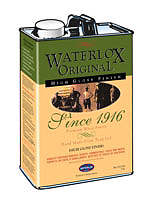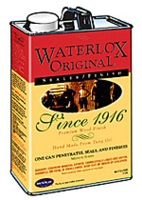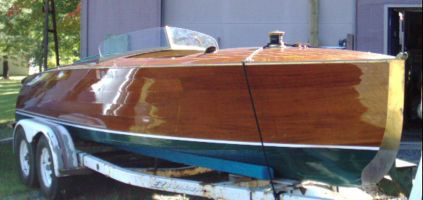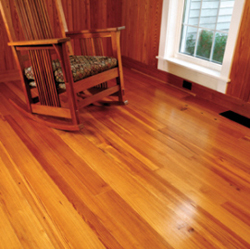
There’s no sin in sincere, no good in goodbye, and no water in Waterlox, and there never has been. What is in there is tung oil, along with some other ingredients, in formulas that have been around for ages.
Waterlox is the brand name of a highly versatile line of resin-modified tung oil coatings that can be wiped, brushed, dipped or sprayed. Its legions of loyal devotees use it for floors, woodwork, furniture, boats, gunstocks and a host of other applications. For 90 years, Waterlox has been made by a company currently owned and run by Jay Hawkins, the grandson of the company’s founder, and Jay’s daughter, Kellie Hawkins Schaffner. “The name,” Jay explained, “means ‘locks out water,’ and the original slogan was ‘The key to your surface protection.’ Appropriately, the old logo sported a skeleton key.
“Waterlox was developed in 1916 by the Empire Varnish Company, which had already been around since 1910,” Jay explained. “The original formula was simply a heat-bodied tung oil with dryers, but somewhere in the 20s, they decided to add phenolic resin to make it more water-resistant. The result was the same basic formula used today. Throughout the 20s, 30s and 40s, the company inched along slowly until Robert L. Hawkins, Jr., the son of the founder, joined the business after graduating from Case Western Reserve. He pursued automotive coatings, and that became their biggest volume seller until the 1980s.”

“In the 60s,” Jay continued, “urban renewal forced us out of our original building. We moved Waterlox to a new facility, and reincorporated as the Waterlox Chemical and Coatings Corporation. The building had already been used for coatings; in fact, paint has been made in that building by one company or another since 1898.”
During the 60s through the 80s, the bulk of their output was automotive, primarily coatings for rubber floor mats. Somewhere around 1988, foreign competition, among other influences, convinced car makers to switch from rubber flooring to carpet. Seeing much of their sales volume drying up, the company decided to refocus.
About the same time, Hawkins’ grandson, Jay, the current CEO, started taking over the helm of the business. He started to aim the business toward wood coatings. As luck would have it, that coincided with a growth in the wood flooring business. Waterlox pitched their Original Sealer Finish as an excellent floor finish, which substantially helped their growth. Floor coating still makes up their largest volume, but that same finish has become quite popular among furniture makers as well. Once called Waterlox Transparent, it is still around, though it is now called Original Sealer Finish.
“Everything in our tung oil line starts with the word original,” Hawkins explained. “That includes Original Sealer Finish, Original Satin, Original High gloss and Original Marine Finish, a high solids coating that weighs in with an impressive 50 percent solids.” The solids are a measure of how much of the finish sticks around, versus how much evaporates. To put it in perspective, lacquer typically varies from 12 percent to 24 percent, while gel urethane usually weighs in around 42 percent solids.
“The Original Sealer Finish is also sold as Original Marine Sealer,” Jay continued. “All of them are resin-modified tung oil products. The Sealer, Satin and Marine Sealer contain tung oil, phenolic resin, a gum rosin, driers and solvent, and all are around 22 percent solids. That combination and solids content makes them penetrate well and makes them easy to apply as a wipe-on finish. It was designed to give the ‘hand-rubbed’ look off a brush, but can be wiped, dipped or sprayed as well. Because it is so versatile, it can be used as a floor finish, a furniture finish and even a marine finish. Our High Gloss Finish, formerly known as Gym Finish, is a 43 percent solids coating containing two different phenolic resins, and is the hardest of all the tung oil finishes we make.”

“Ninety-nine percent of your readers,” Jay advised, “should start with Original Sealer Finish or, for a lower sheen, Original Satin Finish. We consider it the anti-urethane alternative. It is the very best finish to use for furniture and other woodwork and is ideal for virtually every project from kitchen cabinets and wainscot to fine furniture, art turnings and even fly rods and gunstocks. The important issue to remember is that more coats mean more durability, so bear that in mind when you design your finishing schedule.
“However, the Original Sealer Finish is also more than adequate for flooring. It is equal to urethanes in many respects, including wear, and is better at resisting cracking and peeling. Better still, it is much easier to recoat and renew; all you need do is clean it and go. There’s no need for sanding or adding another sealer.”
The company also makes urethane coatings, and has since the 60s. Unlike most urethanes, theirs are based on soy oil, which is lighter in color, yellows less over time and is faster drying. However, Jay insists that tung oil-based finishes adhere better to wood than urethanes, and generally recommends them for flooring. In fact, that is what is on his wood floor. “The number one reason that people prefer our tung oil finishes to urethanes is that they don’t look like a sheet of plastic.”
All in all, about 15 employees make over a dozen different products, and everything is still handmade in the one plant. You can find Waterlox at some hardware stores, though not in the big box stores, and their strongest base is still in the North and East, though Jay says their floor finishes are quite popular on the West Coast. You can buy direct from their web site, or use it to find a local dealer.

The only two stockholders are Jay and his daughter, and they run the company. Both are tireless promoters of their wares, and obviously believe strongly in what they make. “When you start splitting hairs,” Jay insisted, “we believe that tung oil makes a superior finish, and we feel ours is the best, since it is a formulated product rather than pure tung oil. None of the other tung oil formulations are equal to ours.”
“When you really get down to brass tacks, Waterlox has withstood the test of time,” Jay concluded. “It is user-friendly, performs well, and is easy to renew, but at the end of the day, it is the wonderful appearance of Waterlox that makes it the darling of so many fine woodworkers.”





